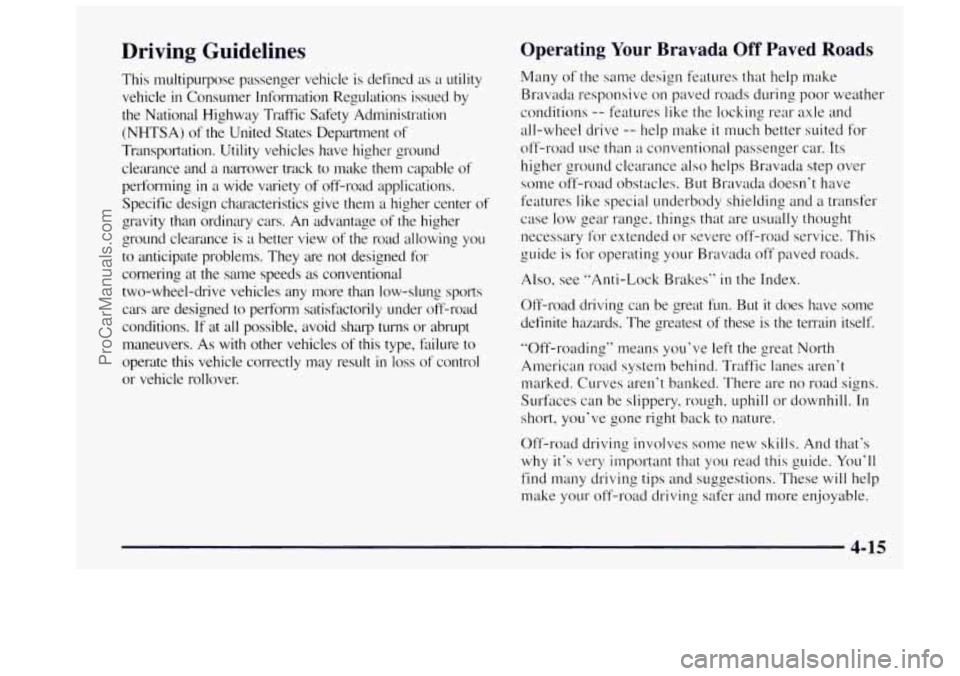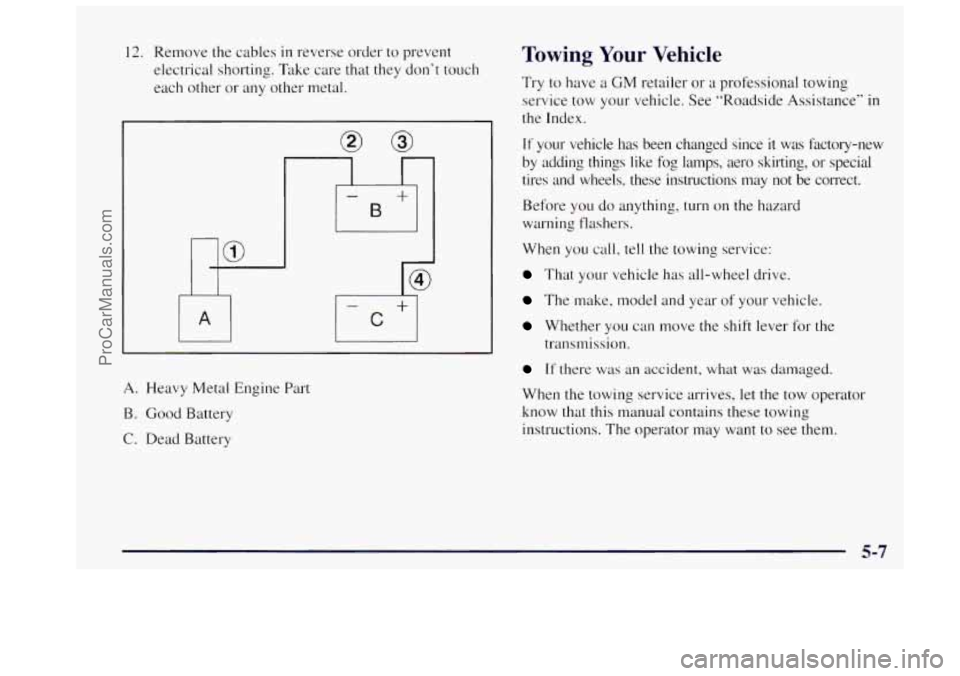1997 OLDSMOBILE BRAVADA service
[x] Cancel search: servicePage 147 of 358

Driving Guidelines
This multiplrpose passenger vehicle is defined as a utility
vehicle in Consumer Information Regulations issued by
the National Highway Traffic Safety Administration
(NHTSA) of the United States Department of
Transportation.
Utility vehicles have higher ground
clearance and a narrower track to make them capable
of
performing in a wide variety of off-road applications.
Specific design characteristics give them a higher center of
gravity than ordinary cars.
An advantage of the higher
ground clearance is
a better view of the road allowing you
to anticipate problems. They are not designed
for
cornering at the same speeds as conventional
two-wheel-drive vehicles any more than low-slung sports
cars are designed to perform satisfactorily under off-road
conditions.
If at all possible, avoid sharp turns or abrupt
maneuvers.
As with other vehicles of this type, failure to
operate this vehicle correctly may result
in loss of control
or vehicle rollover.
Operating Your Bravada Off Paved Roads
Many of the same design features that help make
Bravada responsive on paved roads during poor weather
conditions
-- features like the locking rear axle and
all-wheel drive
-- help make it much better suited for
off-road use than
a conventional passenger car. Its
higher ground clearance also helps Bravada step over
some off-road obstacles.
But Bravada doesn’t have
features like special underbody shielding and a transfer
case low gear range. things that are
LISLI~~~Y thought
necessary for extended or severe off-road service. This
guide is for operating your Bravada off paved roads.
Also, see “Anti-Lock Brakes’’
in the Index.
Off-road driving can be great fun.
But it does have some
definite hazards. The greatest
of these is the terrain itself.
“Off-roading” means you’ve left the great North
American
road system behind. Traffic lanes aren’t
marked. Curves aren’t banked. There are
no road signs.
Surfaces can
be slippery, rough, uphill or downhill. In
short, you’ve gone right back to nature.
Off-road driving involves some new skills. And that’s
why it’s very important that you read this guide. You’ll
find many driving tips and suggestions. These will help
make your off-road driving safer and more enjoyable.
ProCarManuals.com
Page 148 of 358

Before You Go Off-Roading
There are some things to do before you go out. For
example, be sure to have all necessary maintenance and
service work done. Check to make sure all underbody
shields (if
so equipped) are properly attached. Be sure
you read all the information about your
four-wheel-drive vehicle in this manual.
Is there enough
fuel?
Is the spare tire fully inflated? Are the fluid levels
up where they should be? What are the local laws that
apply to off-roading where you’ll be driving? If you
don’t know, you should check with law enforcement
people in the area. Will you be on someone’s private
land? If
so, be sure to get the necessary permission.
Loading Your Vehicle for Off-Road Driving
There are some important things to remember about
how to load your vehicle.
0 The heaviest things should be on the load floor and
forward of your rear axle. Put heavier items as far
forward as you can.
0 Be sure the load is secured properly, so driving on
the off-road terrain doesn’t toss things around.
0 Cargo on the load floor piled higher than
the seatbacks can be thrown forward
during
a sudden stop. You or your
passengers could be injured. Keep cargo
below the top of the seatbacks.
0 Unsecured cargo on the load floor can be
tossed about when driving over rough
terrain. You or your passengers can be
struck by flying objects. Secure the
cargo properly.
0 Heavy loads on the roof raise the vehicle’s
center of gravity, making
it more likely to
roll over. You can be seriously or fatally
injured if the vehicle rolls over. Put heavy
loads inside the cargo area, not on the roof.
Keep cargo in the cargo area
as far forward
and low
as possible.
You’ll find other important information in this manual.
See “Vehicle Loading,” “Luggage Carrier” and “Tires’’
in the Index.
ProCarManuals.com
Page 159 of 358

If the water isn’t too deep, then drive through it slowly. At
fast speeds, water splashes on your ignition system and
your vehicle can stall. Stalling can also occur
if you get
your tailpipe under water. And, as long
as your tailpipe is
under water, you‘ll never be able to stzt your engine.
When you go through water. remember that when your
brakes get wet,
it may take you longer to stop.
I
Driving through rushing water can be dangerous.
Deep water can sweep your vehicle downstream and you and your passengers could drown. If it’s
only shallow water, it can still wash away the
ground from under your tires, and you could lose
traction and roll the vehicle over. Don’t drive
through rushing water.
See “Driving Through Water‘. in the Index for more
information
on driving through water.
After Off-Road Driving
Remove any brush or debris that has collected on the
underbody, chassis or under the hood. These
accumulations can be a fire hazard.
After operation
in mud or sand, have the brake linings
cleaned and checked. These substances can cause
steering, suspension, wheels, tires and exhaust system
for damage. Also, check the fuel lines and cooling
system for any leakage.
2 (.lazing and uneven braking. Check the body structure,
Your vehicle will require more frequent service due to
off-road use. Refer to the Maintenance Schedule for
additional information.
4-27
ProCarManuals.com
Page 167 of 358

Once you are moving on the freeway, make certain you
allow a reasonable following distance. Expect to move
slightly slower at night.
When you want to leave the freeway, nwve to the proper
lane well
in advance. If you miss your exit, do not,
under any circumstances, stop and back up. Drive on to
the next exit.
The exit ramp can be curved, sometimes quite sharply.
The exit speed is usually posted.
Reduce your speed according to your speedometer, not
to your sense
of motion. After driving for any distance
at higher speeds, you may tend to
think you are going
slower than you actually are.
Before Leaving on a Long Trip
Make sure you're ready. Try to be well rested. lf you
must start when you're not fresh
-- such as after a day's
work
-- don't plan to make too many miles that first part
of the journey. Wear comfortable clothing and shoes you
can easily drive
in.
Is your vehicle ready for a long trip'! If you keep it
serviced and maintained, it's ready to go. If it needs
service, have
it done before starting out. Of course,
you'll find experienced and able service experts
in
Oldsmobile retailers all across North America. They'll
be ready and
willing to help if you need it.
Here are some things you can check before a trip:
0
0
0
0
0
0
0
Wildshield Wnsher Fluid: Is the reservoir full'? Are
all windows clean inside and outside'?
Wiper
Blades: Are they in good shape'?
Frwl, EIlgirw Oil, Other Fluids: Have YOU checked
all levels'?
Lcrnzps: 4re they all working? Are the lenses clean'?
Tires: They are vitally important to
a safe,
trouble-free trip.
Is the tread good enough for
long-distance driving? Are the tires
a11 inflated to the
recommended pressure?
Welrther
Forcmsts: What's the weather outlook
along your route? Should you delay your trip a short
time to avoid
a major storm system'?
A4ups: Do you have up-to-date maps'?
4-35
ProCarManuals.com
Page 168 of 358

Highway Hypnosis
Is there actually such a condition as “highway hypnosis”‘?
Or is
it just plain falling asleep at the wheel? Call it
highway hypnosis, lack of awareness, or whatever.
There is something about an easy stretch of road with
the same scenery, along with the
hum of the tires on the
road, the drone
of the engine, and the rush of the wind
against the vehicle that can make you sleepy. Don’t let it
happen to you!
If it does, your vehicle can leave the
road
in less than a second, and you could crash and
be injured.
What can you do about highway hypnosis? Erst, be
aware that
it can happen.
Then here are some tips:
0 Make sure your vehicle is well ventilated, with a
comfortably cool interior.
0 Keep your eyes moving. Scan the road ahead and
to the sides. Check your mirrors and your
instruments frequently.
If you get sleepy, pull off the road into a rest, service
or parking area and take a nap, get some exercise, or
both. For safety, treat drowsiness on the highway
as
an emergency.
Hill and Mountain Roads
Driving on steep hills or mountains is different from
driving
in flat or rolling terrain.
4-36
ProCarManuals.com
Page 184 of 358

When You Are Ready to Leave After
Parking on a Hill
1. Apply your regular brakes and hold the pedal down
while you:
0 Start your engine;
0 Shift into a gear; and
0 Release the parking brake.
2. Let up on the brake pedal.
3. Drive slowly until the trailer is clear of the chocks.
4. Stop and have someone pick up and store the chocks.
Maintenance When Trailer Towing
Your vehicle will need service more often when you’re
pulling a trailer. See the Maintenance Schedule for more
on this. Things that are especially important
in trailer
operation are automatic transmission fluid (don’t
overfill), engine
oil, axle lubricant, belt, cooling system
and brake adjustment. Each of these
is covered in this
manual, and the Index will help you find them quickly.
If you’re trailering, it’s a good idea to review these
sections before you start your trip.
Check periodically to see that all hitch nuts and bolts
are tight.
4-52
ProCarManuals.com
Page 192 of 358

7. Don’t let the other
end touch metal.
Connect
it to the
positive
(+) terminal
of the good battery.
8. Now connect the black
negative
(-) cable to
the good battery’s
negative
(-) terminal.
Don‘t let the other end
touch anything
until the
next step. The other end
of the negative cable
doesn’t go to the dead
battery. It goes to a heavy
unpainted metal part on
the engine of the vehicle
with the dead battery.
9. Attach the cable at
least
18 inches (45 cm)
away from the dead
battery, but not near
engine parts that move.
The electrical
connection is
just
as good there, but
the chance
of sparks
getting back to the
battery
is much less.
10. Now start the vehicle with the good battery and
run the engine for
a while.
11. Try to start the vehicle with the dead battery.
If it won’t start after a few tries, make sure all
connections are good.
If it still won’t start, it
probably needs service.
A CAUTION:
Fans or other moving engine parts can injure you
badly. Keep your hands away from moving parts
once the engines are running.
5-6
ProCarManuals.com
Page 193 of 358

12. Remove the cables in reverse order to prevent
electrical shorting. Take care that they don’t touch
each other or any other metal. Towing Your Vehicle
Try to have a GM retailer or a professional towing
service tow your vehicle. See “Roadside Assistance”
in
the Index.
If your vehicle has been changed since it was factory-new
by adding things like
fog lamps, aero skirting, or special
tires and wheels, these instructions may not be conect.
Before you do anything, turn on the hazard
warning flashers.
When you call, tell the towing service:
That your vehicle has all-wheel drive.
The make, model and year of your vehicle.
Whether you can move the shift lever for the
transmission.
A. Heavy Metal Engine Part
B. Good Battery
C. Dead Battery
If there was an accident, what was damaged.
When the towing service arrives, let the tow operator
know that this manual contains these towing
instructions.
The operator may want to see them.
5-7
ProCarManuals.com